Views on Radiation Shielding Efficiency of Polymeric Composites/Nanocomposites and Multi-Layered Materials: Current State and Advancements
Abstract
:Simple Summary
Abstract
1. Introduction
2. Polymers Composites/Nanocomposites: Fundamentals and Radiation Shielding
3. Epoxy Composites/Nanocomposites for Radiation Shielding
4. Modification of Epoxy Resin with Fibers/Fillers for Radiation Shielding
5. Multi-Layered Radiation Shielding of Polymer Composites/Nanocomposites
6. Conclusions
Author Contributions
Funding
Acknowledgments
Conflicts of Interest
References
- Vanamala, U.M.; Nidamarty, L.P. Galactic cosmic energy-a novel mode of energy harvesting. In International Conference on Emerging Trends in Engineering (ICETE); Springer: Berlin/Heidelberg, Germany, 2020; pp. 458–465. [Google Scholar]
- Georgiou, C.D.; Kalaitzopoulou, E.; Skipitari, M.; Papadea, P.; Varemmenou, A.; Gavriil, V.; Sarantopoulou, E.; Kollia, Z.; Cefalas, A.-C. Physical Differences between Man-Made and Cosmic Microwave Electromagnetic Radiation and Their Exposure Limits, and Radiofrequencies as Generators of Biotoxic Free Radicals. Radiation 2022, 2, 285–302. [Google Scholar] [CrossRef]
- Cucinotta, F.A.; Kim, M.-H.Y.; Chappell, L.J. Evaluating shielding approaches to reduce space radiation cancer risks. NASA Tech. Memo. 2012, 217361. [Google Scholar]
- Fearn, S.J.; Kaluvan, S.; Scott, T.B.; Martin, P.G. An Open-Source Iterative Python Module for the Automated Identification of Photopeaks in Photon Spectra. Radiation 2022, 2, 193–214. [Google Scholar] [CrossRef]
- Torresan, C.; Benito Garzón, M.; O’grady, M.; Robson, T.M.; Picchi, G.; Panzacchi, P.; Tomelleri, E.; Smith, M.; Marshall, J.; Wingate, L. A new generation of sensors and monitoring tools to support climate-smart forestry practices. Can. J. For. Res. 2021, 51, 1751–1765. [Google Scholar] [CrossRef]
- Webber, W.; Villa, T. The galactic cosmic ray electron spectrum from 3 to 70 MeV measured by Voyager 1 beyond the heliopause, what this tells us about the propagation of electrons and nuclei in and out of the galaxy at low energies. arXiv 2017, arXiv:1703.10688. [Google Scholar]
- Uyanna, O.; Najafi, H. Thermal protection systems for space vehicles: A review on technology development, current challenges and future prospects. Acta Astronaut. 2020, 176, 341–356. [Google Scholar] [CrossRef]
- Strand, P.; Larsson, C.-M. 6 Delivering a framework for the protection of the environment from ionising radiation. In Radioactive Pollutants; EDP Sciences: Berlin, Germany, 2022; pp. 131–146. [Google Scholar]
- Shah, S.S.; Shaikh, M.N.; Khan, M.Y.; Alfasane, M.A.; Rahman, M.M.; Aziz, M.A. Present status and future prospects of jute in nanotechnology: A review. Chem. Rec. 2021, 21, 1631–1665. [Google Scholar] [CrossRef]
- Dhand, V.; Mittal, G.; Rhee, K.Y.; Park, S.-J.; Hui, D. A short review on basalt fiber reinforced polymer composites. Compos. Part B Eng. 2015, 73, 166–180. [Google Scholar] [CrossRef]
- Thibeault, S.A.; Kang, J.H.; Sauti, G.; Park, C.; Fay, C.C.; King, G.C. Nanomaterials for radiation shielding. Mrs Bull. 2015, 40, 836–841. [Google Scholar] [CrossRef]
- Sihver, L.; Barghouty, F.; Falconer, D. Space Radiation Risk Reduction through Prediction, Detection and Protection. In Proceedings of the 2021 IEEE Aerospace Conference (50100), Big Sky, MT, USA, 6–13 March 2021; pp. 1–10. [Google Scholar]
- Clarizia, G.; Bernardo, P. Polyether Block Amide as Host Matrix for Nanocomposite Membranes Applied to Different Sensitive Fields. Membranes 2022, 12, 1096. [Google Scholar] [CrossRef]
- Sreekumar, R.; Nair, A.S.; Sreejakumari, S. Recent trends and developments in two-dimensional materials based electrodeposited nickel nanocomposite coatings. FlatChem 2022, 36, 100434. [Google Scholar] [CrossRef]
- Osman, A.; El-Sarraf, M.; Abdel-Monem, A.; Abdo, A.E.-S. Studying the shielding properties of lead glass composites using neutrons and gamma rays. Ann. Nucl. Energy 2015, 78, 146–151. [Google Scholar] [CrossRef]
- Wang, P.; Tang, X.; Chai, H.; Chen, D.; Qiu, Y. Design, fabrication, and properties of a continuous carbon-fiber reinforced Sm2O3/polyimide gamma ray/neutron shielding material. Fusion Eng. Des. 2015, 101, 218–225. [Google Scholar] [CrossRef]
- Park, S.; Kim, H.; Kim, Y.; Kim, E.; Seo, Y. Multilayer-structured non-leaded metal/polymer composites for enhanced X-ray shielding. MRS Adv. 2018, 3, 1789–1797. [Google Scholar] [CrossRef]
- Fai, T.J.; Mark, J.E.; Prasad, P.N. Polymers and Other Advanced Materials: Emerging Technologies and Business Opportunities; Springer: New York, NY, USA, 2013. [Google Scholar]
- Prasad, P.N.; Mark, J.E.; Kandil, S.H.; Kafafi, Z.H. Science and Technology of Polymers and Advanced Materials: Emerging Technologies and Business Opportunities; Springer: New York, NY, USA, 2013. [Google Scholar]
- Nambiar, S.; Yeow, J.T. Polymer-composite materials for radiation protection. ACS Appl. Mater. Interfaces 2012, 4, 5717–5726. [Google Scholar] [CrossRef]
- Oladele, I.O.; Omotosho, T.F.; Adediran, A.A. Polymer-based composites: An indispensable material for present and future applications. Int. J. Polym. Sci. 2020, 2020, 8834518. [Google Scholar] [CrossRef]
- Nambiar, S.; Osei, E.K.; Yeow, J.T. Polymer nanocomposite-based shielding against diagnostic X-rays. J. Appl. Polym. Sci. 2013, 127, 4939–4946. [Google Scholar] [CrossRef]
- Ambika, M.; Nagaiah, N.; Suman, S. Role of bismuth oxide as a reinforcer on gamma shielding ability of unsaturated polyester based polymer composites. J. Appl. Polym. Sci. 2017, 134, 44657. [Google Scholar] [CrossRef]
- Yurt Lambrecht, F.; Ersoz, O.A.; Soylu, H.M. Tungsten-ethylene vinyl acetate (EVA) composite as a gamma rays shielding material. Indian J. Pure Appl. Phys. 2016, 54, 793–796. [Google Scholar]
- Harrison, C.; Weaver, S.; Bertelsen, C.; Burgett, E.; Hertel, N.; Grulke, E. Polyethylene/boron nitride composites for space radiation shielding. J. Appl. Polym. Sci. 2008, 109, 2529–2538. [Google Scholar] [CrossRef]
- Gwaily, S.; Badawy, M.; Hassan, H.; Madani, M. Natural rubber composites as thermal neutron radiation shields: I. B4C/NR composites. Polym. Test. 2002, 21, 129–133. [Google Scholar] [CrossRef]
- Adeli, R.; Shirmardi, S.P.; Ahmadi, S.J. Neutron irradiation tests on B4C/epoxy composite for neutron shielding application and the parameters assay. Radiat. Phys. Chem. 2016, 127, 140–146. [Google Scholar] [CrossRef]
- Chang, L.; Zhang, Y.; Liu, Y.; Fang, J.; Luan, W.; Yang, X.; Zhang, W. Preparation and characterization of tungsten/epoxy composites for γ-rays radiation shielding. Nucl. Instrum. Methods Phys. Res. Sect. B Beam Interact. Mater. At. 2015, 356, 88–93. [Google Scholar] [CrossRef]
- Kaçal, M.; Dilsiz, K.; Akman, F.; Polat, H. Analysis of radiation attenuation properties for Polyester/Li2WO4 composites. Radiat. Phys. Chem. 2021, 179, 109257. [Google Scholar] [CrossRef]
- Lanina, S.; Kaminskaya, N.; Benyaev, N.; Suslova, V.; Grigorevskaya, M. On possible use of inorganic fillers and matrix polymers in radiation shielding materials. Biomed. Eng. 2013, 46, 228–231. [Google Scholar] [CrossRef]
- Kilicoglu, O.; Kara, U.; Inanc, I. The impact of polymer additive for N95 masks on gamma-ray attenuation properties. Mater. Chem. Phys. 2021, 260, 124093. [Google Scholar] [CrossRef]
- Mirji, R.; Lobo, B. Computation of the mass attenuation coefficient of polymeric materials at specific gamma photon energies. Radiat. Phys. Chem. 2017, 135, 32–44. [Google Scholar] [CrossRef]
- Sayyed, M. Investigation of shielding parameters for smart polymers. Chin. J. Phys. 2016, 54, 408–415. [Google Scholar] [CrossRef]
- Bhosale, R.R.; More, C.V.; Gaikwad, D.K.; Pawar, P.P.; Rode, M.N. Radiation shielding and gamma ray attenuation properties of some polymers. Nucl. Technol. Radiat. Prot. 2017, 32, 288–293. [Google Scholar] [CrossRef] [Green Version]
- Mann, K.S.; Rani, A.; Heer, M.S. Shielding behaviors of some polymer and plastic materials for gamma-rays. Radiat. Phys. Chem. 2015, 106, 247–254. [Google Scholar] [CrossRef]
- Kaphle, A.; Navya, P.; Umapathi, A.; Daima, H.K. Nanomaterials for agriculture, food and environment: Applications, toxicity and regulation. Environ. Chem. Lett. 2018, 16, 43–58. [Google Scholar] [CrossRef]
- More, C.V.; Alsayed, Z.; Badawi, M.; Thabet, A.; Pawar, P.P. Polymeric composite materials for radiation shielding: A review. Environ. Chem. Lett. 2021, 19, 2057–2090. [Google Scholar] [CrossRef] [PubMed]
- Ivanov, V.A.C.S. Radiation Chemistry of Polymers; Vsp: Rancho Cordova, CA, USA, 1992; Volume 5. [Google Scholar]
- Kaçal, M.; Akman, F.; Sayyed, M. Evaluation of gamma-ray and neutron attenuation properties of some polymers. Nucl. Eng. Technol. 2019, 51, 818–824. [Google Scholar] [CrossRef]
- Meziani, M.J.; Song, W.L.; Wang, P.; Lu, F.; Hou, Z.; Anderson, A.; Maimaiti, H.; Sun, Y.P. Boron nitride nanomaterials for thermal management applications. ChemPhysChem 2015, 16, 1339–1346. [Google Scholar] [CrossRef] [PubMed]
- Durante, M. Space radiation protection: Destination Mars. Life Sci. Space Res. 2014, 1, 2–9. [Google Scholar] [CrossRef] [PubMed]
- Tessa, C.L.; Guetersloh, S.B.; Heilbronn, L.H.; Miller, J.; Sihver, L.; Zeitlin, C. Fragmentation of 1 GeV/nucleon iron ions in thick targets relevant for space exploration. Adv. Space Res. 2005, 35, 223–229. [Google Scholar] [CrossRef]
- Shavers, M.; Zapp, N.; Barber, R.; Wilson, J.; Qualls, G.; Toupes, L.; Ramsey, S.; Vinci, V.; Smith, G.; Cucinotta, F. Implementation of ALARA radiation protection on the ISS through polyethylene shielding augmentation of the Service Module Crew Quarters. Adv. Space Res. 2004, 34, 1333–1337. [Google Scholar] [CrossRef]
- Kodaira, S.; Tolochek, R.; Ambrozova, I.; Kawashima, H.; Yasuda, N.; Kurano, M.; Kitamura, H.; Uchihori, Y.; Kobayashi, I.; Hakamada, H. Verification of shielding effect by the water-filled materials for space radiation in the International Space Station using passive dosimeters. Adv. Space Res. 2014, 53, 1–7. [Google Scholar] [CrossRef]
- Chawla, K. Fibrous Materials; Cambridge University Press: Cambridge, UK, 2016. [Google Scholar]
- Miskolczi, N. Polyester resins as a matrix material in advanced fibre-reinforced polymer (FRP) composites. In Advanced Fibre-Reinforced Polymer (FRP) Composites for Structural Applications; Elsevier: Amsterdam, The Netherlands, 2013; pp. 44–68. [Google Scholar]
- Jin, F.-L.; Li, X.; Park, S.-J. Synthesis and application of epoxy resins: A review. J. Ind. Eng. Chem. 2015, 29, 1–11. [Google Scholar] [CrossRef]
- Clyne, T.; Hull, D. An Introduction to Composite Materials; Cambridge University Press: Cambridge, UK, 2019. [Google Scholar]
- Withers, G.; Yu, Y.; Khabashesku, V.; Cercone, L.; Hadjiev, V.; Souza, J.; Davis, D. Improved mechanical properties of an epoxy glass–fiber composite reinforced with surface organomodified nanoclays. Compos. Part B Eng. 2015, 72, 175–182. [Google Scholar] [CrossRef]
- Kaynak, C.; Orgun, O.; Tincer, T. Matrix and interface modification of short carbon fiber-reinforced epoxy. Polym. Test. 2005, 24, 455–462. [Google Scholar] [CrossRef]
- Siedlaczek, P.; Sinn, G.; Peter, P.; Wan-Wendner, R.; Lichtenegger, H.C. Characterization of moisture uptake and diffusion mechanisms in particle-filled composites. Polymer 2022, 249, 124799. [Google Scholar] [CrossRef]
- Al-Sarray, E.; Akkurt, I.; Günoğlu, K.; Evcin, A.; Bezir, N. Radiation Shielding Properties of Some Composite Panel. Acta Phys. Pol. A 2017, 132, 490–492. [Google Scholar] [CrossRef]
- Singh, S.K.; Akhtar, M.; Kar, K.K. Impact of Al2O3, TiO2, ZnO and BaTiO3 on the microwave absorption properties of exfoliated graphite/epoxy composites at X-band frequencies. Compos. Part B Eng. 2019, 167, 135–146. [Google Scholar] [CrossRef]
- KILIÇ, M.; ERGİN, Y.; KARABUL, Y.; ÖZDEMİR, Z.G. Experimental comparison of PbO and BaO addition effect on gamma ray shielding performance of epoxy polymer. Avrupa Bilim Teknol. Derg. 2019, 16, 256–266. [Google Scholar]
- Li, R.; Gu, Y.; Wang, Y.; Yang, Z.; Li, M.; Zhang, Z. Effect of particle size on gamma radiation shielding property of gadolinium oxide dispersed epoxy resin matrix composite. Mater. Res. Express 2017, 4, 035035. [Google Scholar] [CrossRef]
- More, C.V.; Pawar, P.P.; Badawi, M.S.; Thabet, A.A. Extensive theoretical study of gamma-ray shielding parameters using epoxy resin-metal chloride mixtures. Nucl. Technol. Radiat. Prot. 2020, 35, 138–149. [Google Scholar] [CrossRef]
- Alavian, H.; Samie, A.; Tavakoli-Anbaran, H. Experimental and Monte Carlo investigations of gamma ray transmission and buildup factors for inorganic nanoparticle/epoxy composites. Radiat. Phys. Chem. 2020, 174, 108960. [Google Scholar] [CrossRef]
- Saiyad, M.; Devashrayee, N.M.; Mevada, R.K. Study the effect of dispersion of filler in polymer composite for radiation shielding. Polym. Compos. 2014, 35, 1263–1266. [Google Scholar] [CrossRef]
- Azman, N.N.; Siddiqui, S.; Hart, R.; Low, I.-M. Effect of particle size, filler loadings and X-ray tube voltage on the transmitted x-ray transmission in tungsten oxide—Epoxy composites. Appl. Radiat. Isot. 2013, 71, 62–67. [Google Scholar] [CrossRef] [Green Version]
- Aldhuhaibat, M.J.; Amana, M.S.; Jubier, N.J.; Salim, A. Improved gamma radiation shielding traits of epoxy composites: Evaluation of mass attenuation coefficient, effective atomic and electron number. Radiat. Phys. Chem. 2021, 179, 109183. [Google Scholar] [CrossRef]
- La, L.B.; Leatherday, C.; Leong, Y.-K.; Watts, H.P.; Zhang, L.-C. Green lightweight lead-free Gd2O3/epoxy nanocomposites with outstanding X-ray attenuation performance. Compos. Sci. Technol. 2018, 163, 89–95. [Google Scholar] [CrossRef]
- Karabul, Y.; İçelli, O. The assessment of usage of epoxy based micro and nano-structured composites enriched with Bi2O3 and WO3 particles for radiation shielding. Results Phys. 2021, 26, 104423. [Google Scholar] [CrossRef]
- Prabhu, S.; Bubbly, S.; Gudennavar, S. Bismuth (III) oxide decorated graphene oxide filled epoxy nanocomposites: Thermo-mechanical and photon attenuation properties. Adv. Compos. Mater. 2022, 1–27. [Google Scholar] [CrossRef]
- Cha, J.-H.; Jang, W.-H.; Kumar, S.K.S.; Noh, J.-E.; Choi, J.-S.; Kim, C.-G. Functionalized multi-walled carbon nanotubes/hydrogen-rich benzoxazine nanocomposites for cosmic radiation shielding with enhanced mechanical properties and space environment resistance. Compos. Sci. Technol. 2022, 228, 109634. [Google Scholar] [CrossRef]
- Parameswarreddy, G.; Yadam, Y.R.; Arunachalam, K.; Sarathi, R.; Suematsu, H. Investigation on the enhancement of electromagnetic shielding with efficient use of short carbon fiber in MWCNT-epoxy nanocomposites. Polym. Compos. 2022. [Google Scholar] [CrossRef]
- Nanni, F.; Travaglia, P.; Valentini, M. Effect of carbon nanofibres dispersion on the microwave absorbing properties of CNF/epoxy composites. Compos. Sci. Technol. 2009, 69, 485–490. [Google Scholar] [CrossRef]
- Gupta, S.; Chang, C.; Anbalagan, A.K.; Lee, C.-H.; Tai, N.-H. Reduced graphene oxide/zinc oxide coated wearable electrically conductive cotton textile for high microwave absorption. Compos. Sci. Technol. 2020, 188, 107994. [Google Scholar] [CrossRef]
- Song, C.; Yin, X.; Han, M.; Li, X.; Hou, Z.; Zhang, L.; Cheng, L. Three-dimensional reduced graphene oxide foam modified with ZnO nanowires for enhanced microwave absorption properties. Carbon 2017, 116, 50–58. [Google Scholar] [CrossRef]
- Liang, C.; Song, P.; Qiu, H.; Zhang, Y.; Ma, X.; Qi, F.; Gu, H.; Kong, J.; Cao, D.; Gu, J. Constructing interconnected spherical hollow conductive networks in silver platelets/reduced graphene oxide foam/epoxy nanocomposites for superior electromagnetic interference shielding effectiveness. Nanoscale 2019, 11, 22590–22598. [Google Scholar] [CrossRef]
- Aygün, H.H. Epoxy Composites for Radiation Shielding. In Epoxy-Based Composites; IntechOpen: London, UK, 2022; p. 105. [Google Scholar]
- Kim, S.-C. Analysis of Shielding Performance of Radiation-Shielding Materials According to Particle Size and Clustering Effects. Appl. Sci. 2021, 11, 4010. [Google Scholar] [CrossRef]
- Uddin, Z.; Yasin, T.; Shafiq, M. Development of novel silane modified boric acid/high density polyethylene composites for radiation shielding applications. Radiat. Phys. Chem. 2022, 192, 109909. [Google Scholar] [CrossRef]
- Azman, M.N.; Abualroos, N.J.; Yaacob, K.A.; Zainon, R. Feasibility of nanomaterial tungsten carbide as lead-free nanomaterial-based radiation shielding. Radiat. Phys. Chem. 2022, 202, 110492. [Google Scholar] [CrossRef]
- Shreef, A.M.; Abdulzahara, N.A. Manufacture of Shielding for Attenuation Ionization Ray by the Preparation of Nano Gadolinium Oxide with PMMA. NeuroQuantology 2021, 19, 66. [Google Scholar] [CrossRef]
- Zheng, L.-F.; Wang, L.-N.; Wang, Z.-Z.; Wang, L. Effects of γ-ray irradiation on the fatigue strength, thermal conductivities and thermal stabilities of the glass fibres/epoxy resins composites. Acta Metall. Sin. Engl. Lett. 2018, 31, 105–112. [Google Scholar] [CrossRef] [Green Version]
- Li, R.; Gu, Y.; Zhang, G.; Yang, Z.; Li, M.; Zhang, Z. Radiation shielding property of structural polymer composite: Continuous basalt fiber reinforced epoxy matrix composite containing erbium oxide. Compos. Sci. Technol. 2017, 143, 67–74. [Google Scholar] [CrossRef]
- Phong, N.T.; Gabr, M.H.; Okubo, K.; Chuong, B.; Fujii, T. Enhancement of mechanical properties of carbon fabric/epoxy composites using micro/nano-sized bamboo fibrils. Mater. Des. 2013, 47, 624–632. [Google Scholar] [CrossRef]
- Nguyen, D.M.; Vu, T.N.; Nguyen, T.M.L.; Nguyen, T.D.; Thuc, C.N.H.; Bui, Q.B.; Colin, J.; Perré, P. Synergistic influences of stearic acid coating and recycled PET microfibers on the enhanced properties of composite materials. Materials 2020, 13, 1461. [Google Scholar] [CrossRef] [Green Version]
- Abu Saleem, R.A.; Abdelal, N.; Alsabbagh, A.; Al-Jarrah, M.; Al-Jawarneh, F. Radiation shielding of fiber reinforced polymer composites incorporating lead nanoparticles—An empirical approach. Polymers 2021, 13, 3699. [Google Scholar] [CrossRef]
- Hoffman, E.; Skidmore, T. Radiation effects on epoxy/carbon-fiber composite. J. Nucl. Mater. 2009, 392, 371–378. [Google Scholar] [CrossRef] [Green Version]
- Zhong, W.; Sui, G.; Jana, S.; Miller, J. Cosmic radiation shielding tests for UHMWPE fiber/nano-epoxy composites. Compos. Sci. Technol. 2009, 69, 2093–2097. [Google Scholar] [CrossRef]
- Mani, V.; Prasad, N.S.; Kelkar, A. Ultra high molecular weight polyethylene (UHMWPE) fiber epoxy composite hybridized with Gadolinium and Boron nanoparticles for radiation shielding. In Planetary Defense and Space Environment Applications; SPIE: Bellingham, WA, USA, 2016; pp. 115–124. [Google Scholar]
- Kim, S.; Ahn, Y.; Song, S.H.; Lee, D. Tungsten nanoparticle anchoring on boron nitride nanosheet-based polymer nanocomposites for complex radiation shielding. Compos. Sci. Technol. 2022, 221, 109353. [Google Scholar] [CrossRef]
- Zegaoui, A.; Derradji, M.; Medjahed, A.; Ghouti, H.A.; Cai, W.-A.; Liu, W.-B.; Dayo, A.Q.; Wang, J.; Liu, Y.-G. Exploring the hybrid effects of short glass/basalt fibers on the mechanical, thermal and gamma-radiation shielding properties of DCBA/BA-a resin composites. Polym. Plast. Technol. Mater. 2020, 59, 311–322. [Google Scholar] [CrossRef]
- Li, Q.; Wei, Q.; Zheng, W.; Zheng, Y.; Okosi, N.; Wang, Z.; Su, M. Enhanced radiation shielding with conformal light-weight nanoparticle–polymer composite. ACS Appl. Mater. Interfaces 2018, 10, 35510–35515. [Google Scholar] [CrossRef]
- Sayyed, M.; Kaky, K.M.; Mhareb, M.; Abdalsalam, A.H.; Almousa, N.; Shkoukani, G.; Bourham, M.A. Borate multicomponent of bismuth rich glasses for gamma radiation shielding application. Radiat. Phys. Chem. 2019, 161, 77–82. [Google Scholar] [CrossRef]
- Alajerami, Y.; Drabold, D.; Mhareb, M.; Cimatu, K.L.A.; Chen, G.; Kurudirek, M. Radiation shielding properties of bismuth borate glasses doped with different concentrations of cadmium oxides. Ceram. Int. 2020, 46, 12718–12726. [Google Scholar] [CrossRef]
- Mhareb, M.; Sayyed, M.; Flemban, T.; Dwaikat, N.; Ashiq, M.; Alajerami, Y. Experimental shielding properties for a novel glassy system. Appl. Radiat. Isot. 2022, 189, 110408. [Google Scholar] [CrossRef]
- Bel, T.; Mehranpour, S.; Şengül, A.V.; Camtakan, Z.; Baydogan, N. Electron beam penetration of poly (methyl methacrylate)/colemanite composite irradiated at low earth orbit space radiation environment. J. Appl. Polym. Sci. 2021, 138, 51337. [Google Scholar] [CrossRef]
- Mandour, M.A.; Hassan, M. Neutron buildup factors for multilayered-media. Isot. Isot. Environ. Health Stud. 1987, 23, 437–442. [Google Scholar] [CrossRef]
- Shin, K.; HIRAYMA, H. Description of multilayered gamma-ray exposure buildup factors up to 40 mfp by the approximating model. J. Nucl. Sci. Technol. 1998, 35, 865–873. [Google Scholar] [CrossRef]
- Kuspa, J.P. Calculation of Buildup Factors for Multilayer Slab Shields Using the Monte Carlo Method. Master’s Thesis, University of Missouri, Rolla, MO, USA, 1972. [Google Scholar]
- Abbas, J. Calculation of buildup factor for gamma-ray exposure in two layered shields made of water and lead. J. Kufa-Phys. 2012, 4, 1–10. [Google Scholar]
- Al-Arif, M.S.; Kakil, D.O. Calculated-experimental model for multilayer shield. ARO-Sci. J. Koya Univ. 2015, 3, 23–27. [Google Scholar]
- Mann, K.S.; Heer, M.S.; Rani, A. Gamma-ray double-layered transmission exposure buildup factors of some engineering materials, a comparative study. Radiat. Phys. Chem. 2016, 125, 27–40. [Google Scholar] [CrossRef]
- Fuse, T.; Yamaji, A.; Miura, T. The optimum arrangement of laminated iron-water shields. Nucl. Eng. Des. 1970, 13, 390–394. [Google Scholar] [CrossRef]
- McCaffrey, J.; Mainegra-Hing, E.; Shen, H. Optimizing non-Pb radiation shielding materials using bilayers. Med. Phys. 2009, 36, 5586–5594. [Google Scholar] [CrossRef]
- Sariyer, D.; Küçer, R. Double-layer neutron shield design as neutron shielding application. In AIP Conference Proceedings; AIP Publishing LLC: Melville, NY, USA, 2018; p. 180004. [Google Scholar]
- Hu, H.; Wang, Q.; Qin, J.; Wu, Y.; Zhang, T.; Xie, Z.; Jiang, X.; Zhang, G.; Xu, H.; Zheng, X. Study on Composite Material for Shielding Mixed Neutron and γ-Rays. IEEE Trans. Nucl. Sci. 2008, 55, 2376–2384. [Google Scholar] [CrossRef]
- Kim, B.S.; Moon, J.H. Use of a genetic algorithm in the search for a near-optimal shielding design. Ann. Nucl. Energy 2010, 37, 120–129. [Google Scholar] [CrossRef]
- Cai, Y.; Hu, H.; Pan, Z.; Hu, G.; Zhang, T. A method to optimize the shield compact and lightweight combining the structure with components together by genetic algorithm and MCNP code. Appl. Radiat. Isot. 2018, 139, 169–174. [Google Scholar] [CrossRef]
- Whetstone, Z.D.; Kearfott, K.J. Layered shielding design for an active neutron interrogation system. Radiat. Phys. Chem. 2016, 125, 69–74. [Google Scholar] [CrossRef] [Green Version]
- Kim, Y.; Park, S.; Seo, Y. Enhanced X-ray shielding ability of polymer–nonleaded metal composites by multilayer structuring. Ind. Eng. Chem. Res. 2015, 54, 5968–5973. [Google Scholar] [CrossRef]
- Türkaslan, S.S.; Ugur, Ş.S.; Türkaslan, B.E.; Fantuzzi, N. Evaluating the X-ray-Shielding Performance of Graphene-Oxide-Coated Nanocomposite Fabric. Materials 2022, 15, 1441. [Google Scholar] [CrossRef]
- Miller, J.; Zeitlin, C.; Cucinotta, F.; Heilbronn, L.; Stephens, D.; Wilson, J. Benchmark studies of the effectiveness of structural and internal materials as radiation shielding for the international space station. Radiat. Res. 2003, 159, 381–390. [Google Scholar] [CrossRef] [Green Version]
- Lin, R. Energetic electrons accelerated in solar particle events. In AIP Conference Proceedings; American Institute of Physics: Melville, NY USA, 2000; pp. 32–38. [Google Scholar]
- Carron, N.J. An Introduction to the Passage of Energetic Particles through Matter; Taylor & Francis: The Hague, The Netherlands, 2006. [Google Scholar]
- Waly, E.-S.A.; Bourham, M.A. Comparative study of different concrete composition as gamma-ray shielding materials. Ann. Nucl. Energy 2015, 85, 306–310. [Google Scholar] [CrossRef]
- Zhen, X.; Huang, Y.; Yang, S.; Feng, Z.; Ba, D.; Zhuang, J.; Wang, Y.; Qin, X. The effect of proton irradiation on the properties of a graphene oxide paper. RSC Adv. 2019, 9, 30519–30525. [Google Scholar] [CrossRef] [PubMed] [Green Version]
- Yuan, B.; Wang, B.; Hu, Y.; Mu, X.; Hong, N.; Liew, K.M.; Hu, Y. Electrical conductive and graphitizable polymer nanofibers grafted on graphene nanosheets: Improving electrical conductivity and flame retardancy of polypropylene. Compos. Part A Appl. Sci. Manuf. 2016, 84, 76–86. [Google Scholar] [CrossRef]
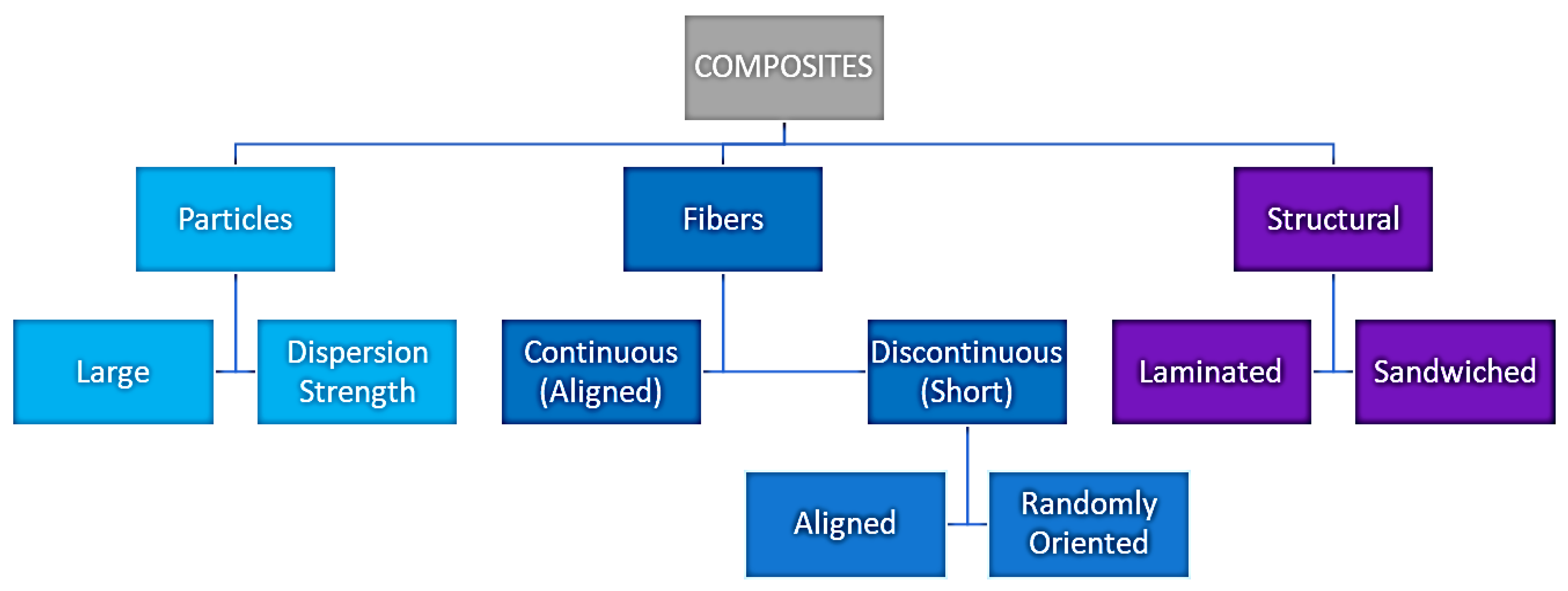
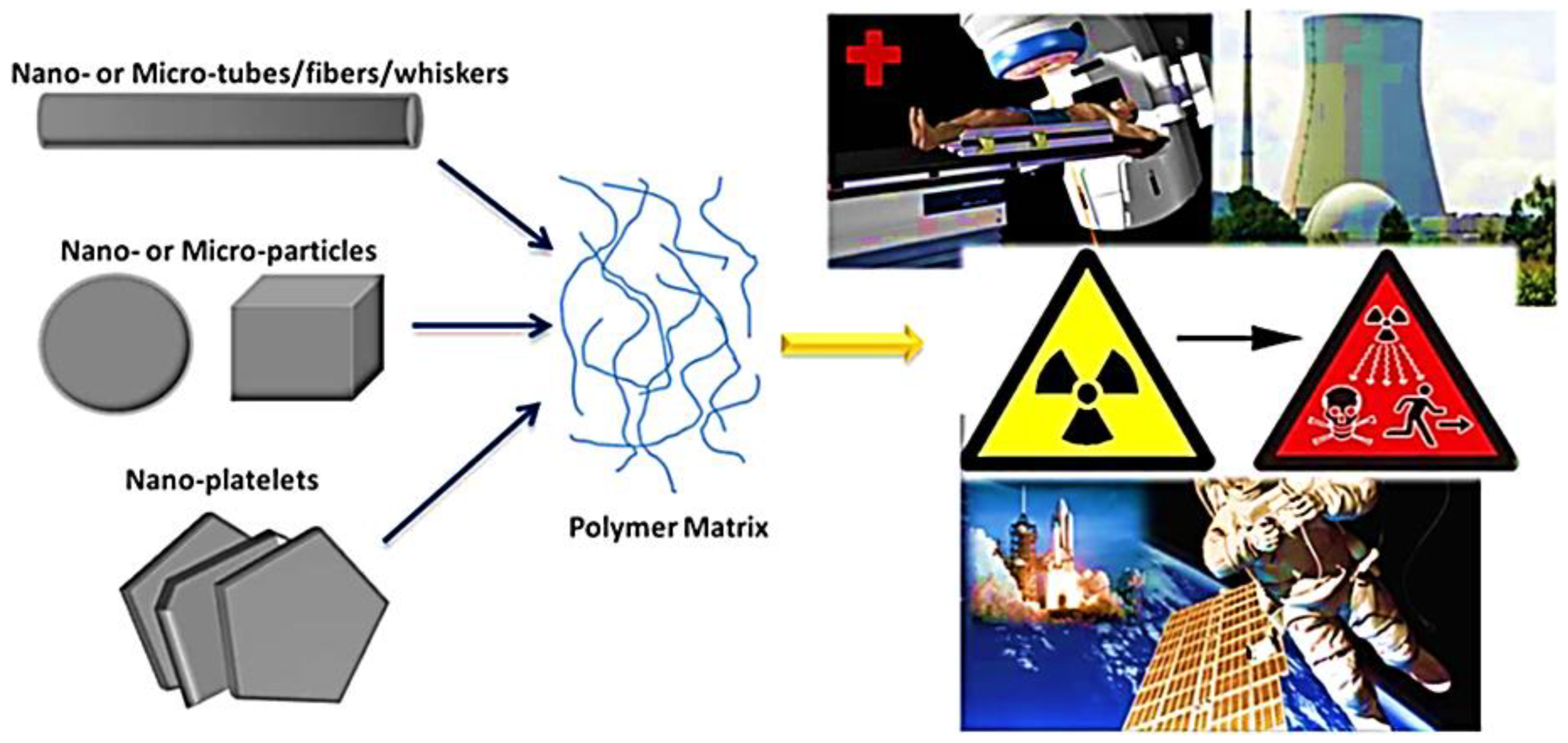
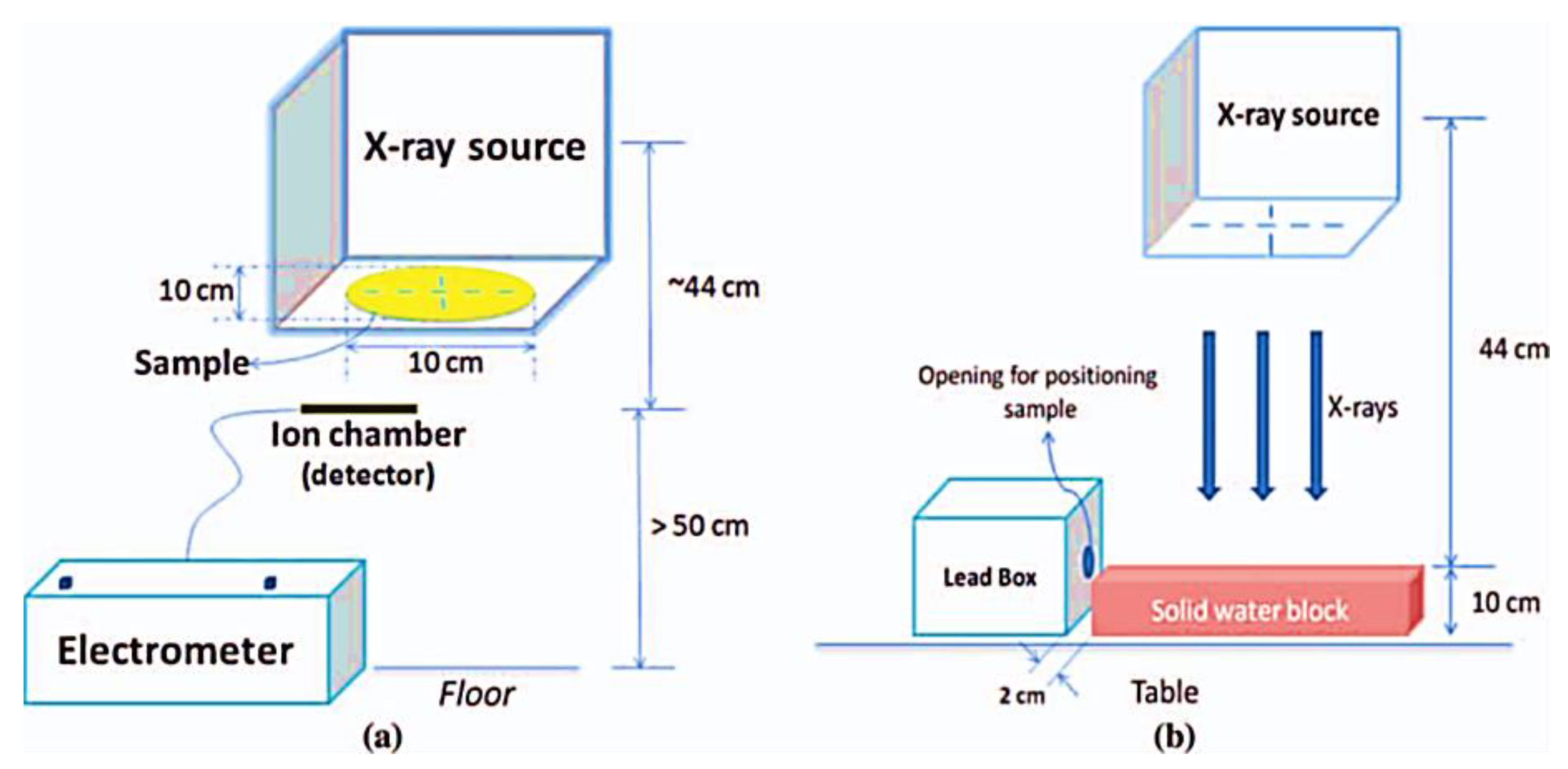
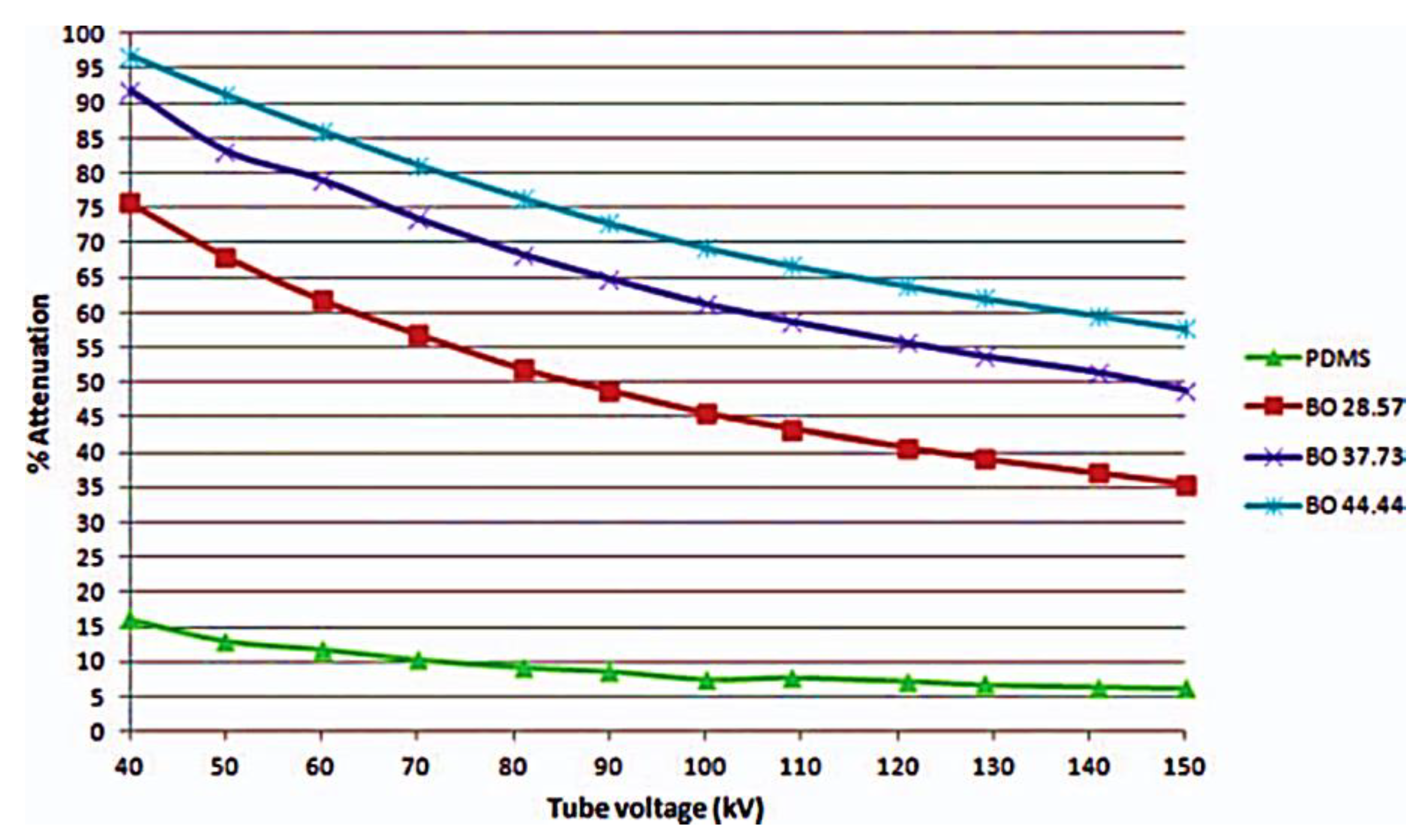
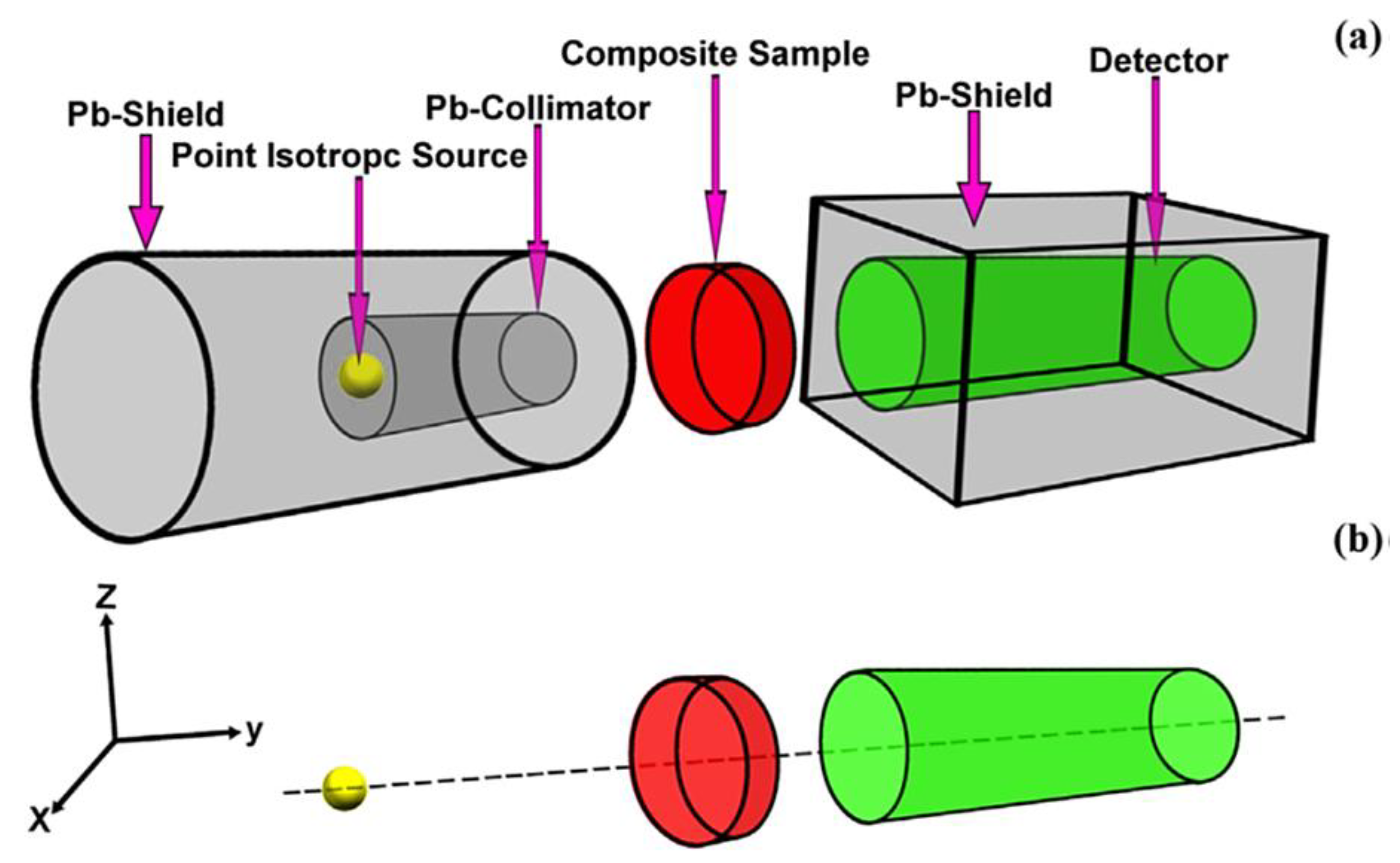
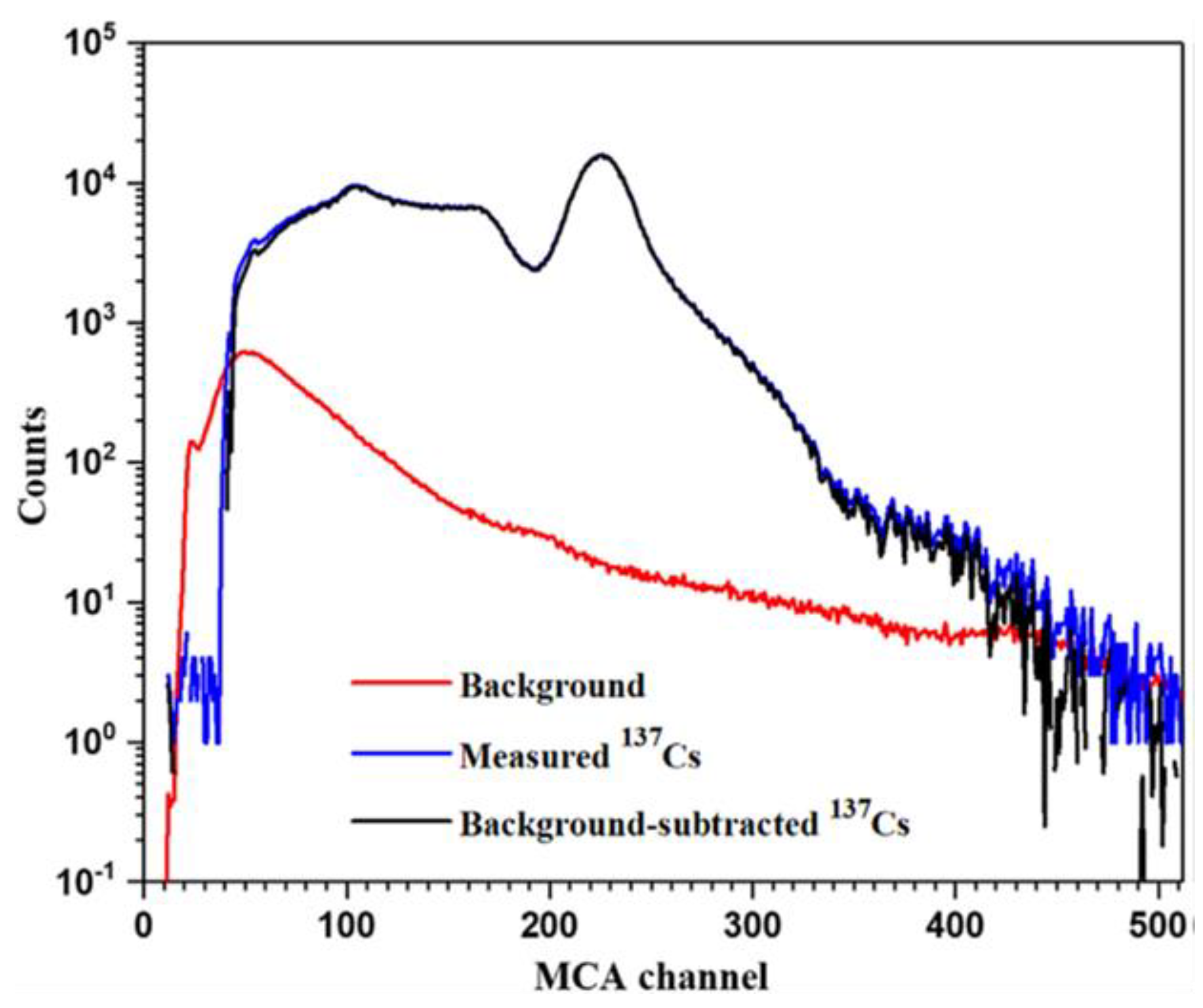

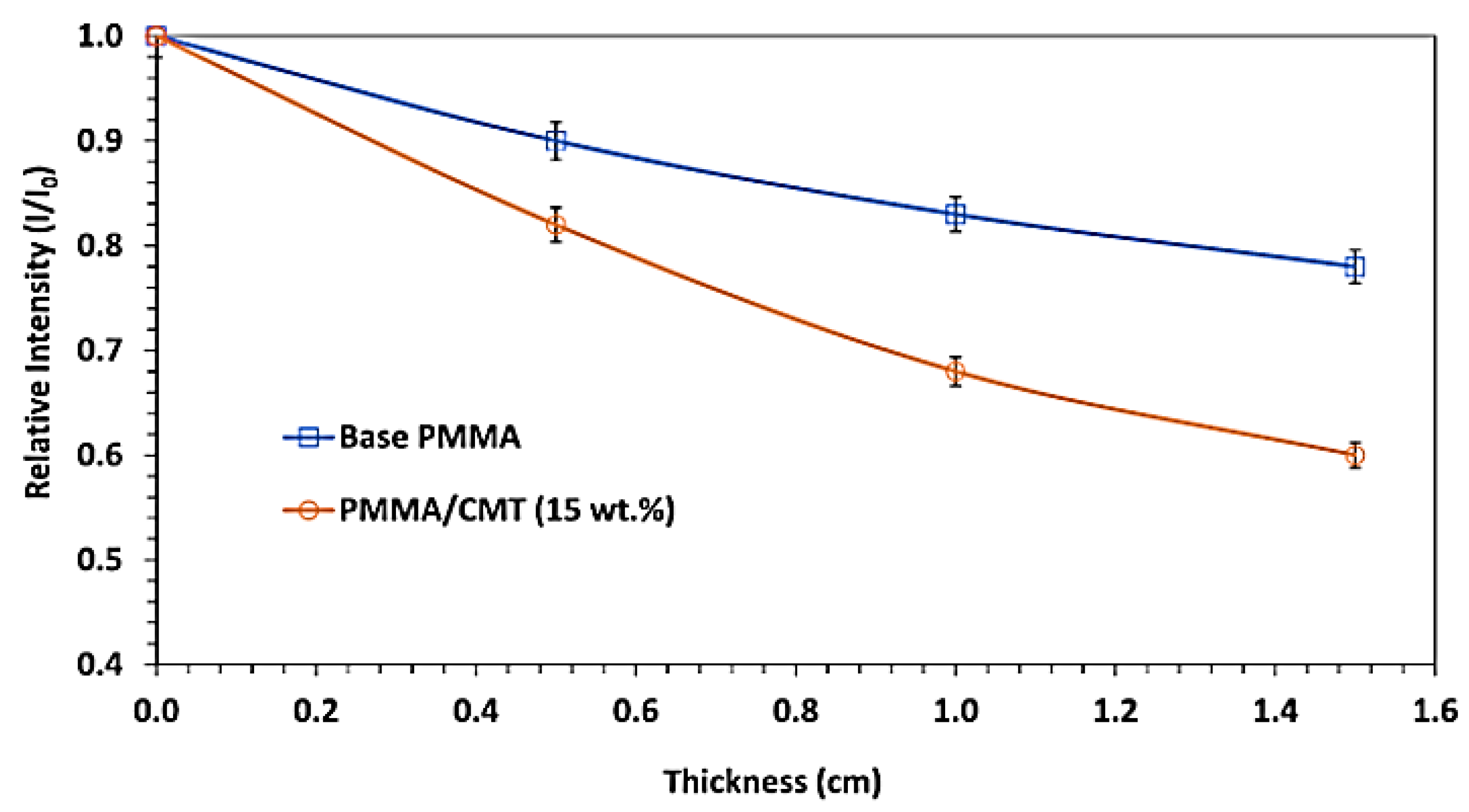
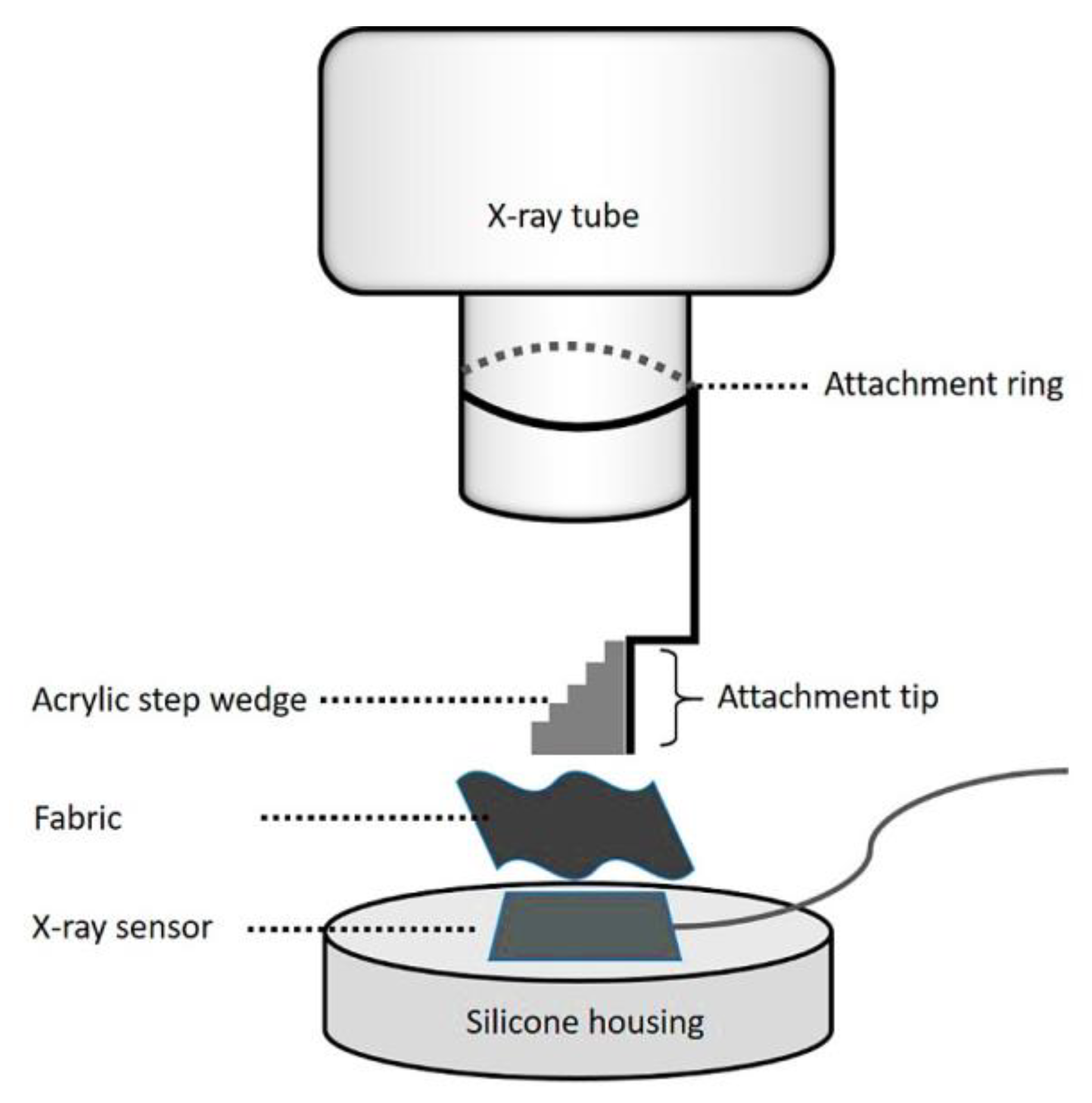
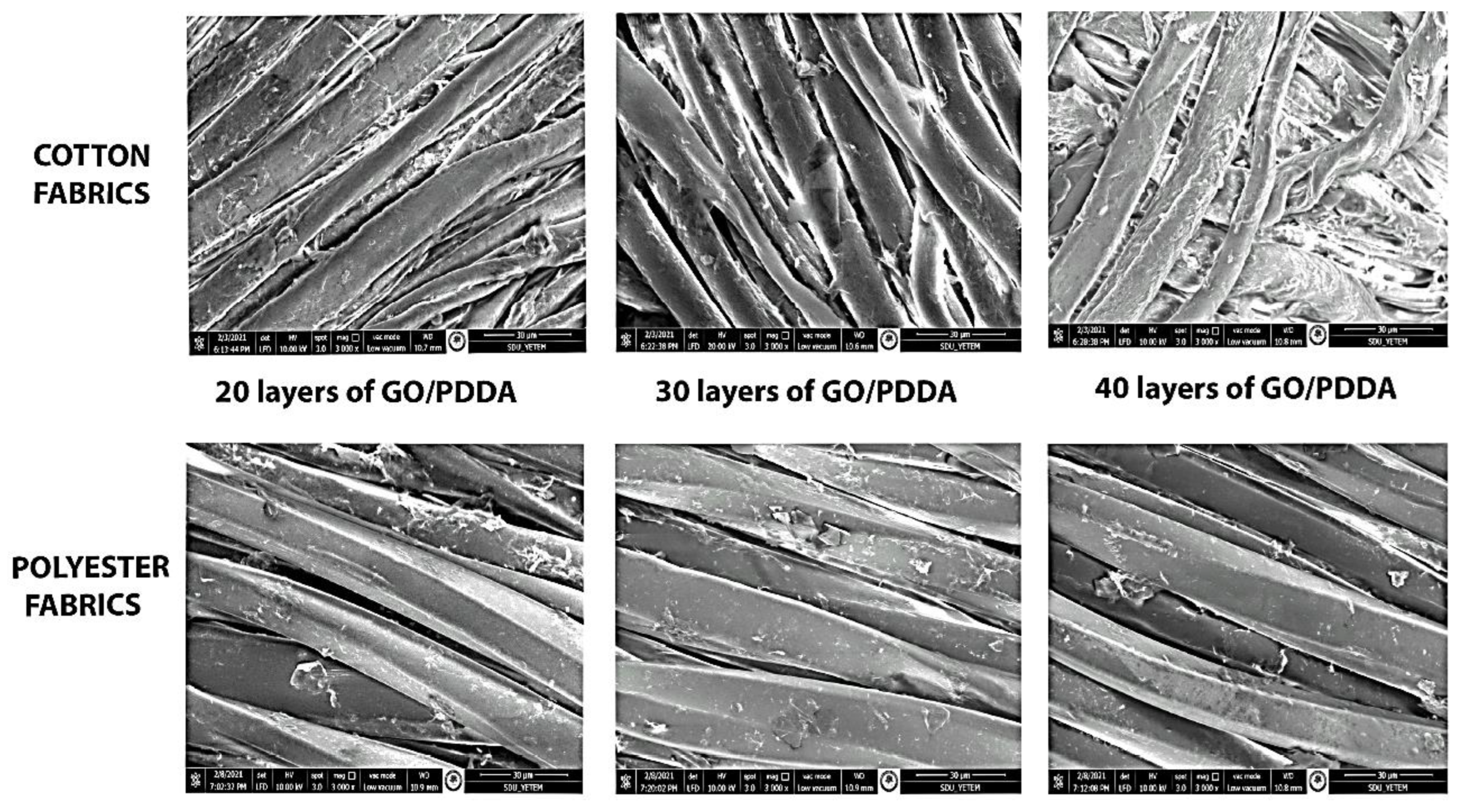
| Industries | Materials | Standard Material | Mass Density | Thermal Conductivity & Material Strength | Formability | Toxicity |
|---|---|---|---|---|---|---|
| Aerospace | Neat polymers such as epoxy, polyethylene, polyether-imide, poly sulfone, etc. | Aluminum or metal alloys | Low | Equivalent or bit low | High | Very low |
| Aerospace/automobile/transportation | Polymer plus micro/nanofillers such as graphite, carbon fiber, carbon nanotube, nano-clay, etc. | Aluminum or metal alloys | Low | Equivalent or low | High | Low |
| Materials Utilized | Shielding Performance | Radiation | Ref. |
|---|---|---|---|
| Carbon Fabric/Polyether ether ketone | 17% higher than Aluminum (Al) (13 and 31 g/cm2) | For heavy and light ions | [105] |
| Carbon fiber reinforced plastic and SiC composite plastic | Dose reduction 1.9 times compared with Al | - | [106] |
| Multilayered shield of composite/tantalum/composite | Radiation shielding efficiency equivalent to Al but 25% mass reduction | - | [6] |
| Carbon fabric coated with heavy metals | Flexible shield better performance than lead and Al shields | - | [11] |
| Natural materials (Boron, Aluminum, lead, etc.) mixed with cement | Hard shield better than lead and Al | Gamma & Neutrons | [107] |
| Tungsten composite and polyethylene terephthalate fiber fabrics containing BaSO4 | Radiation shielding equivalent to 0.018 mm Pb and 0.03 mm Pb | Cosmic radiations | [20] |
| Poly(dimethyl sulfoxide) (PDMS)/multi-walled carbon nanotube nanocomposite | Lighter than pure Al and PDMS shields with comparable shielding effect | High Energy Protons | [108] |
| Graphene oxide coated nanocomposite flexible fabric | Promising for X-ray shielding | X-Rays | [104] |
| Graphene oxide paper | Study of chemical changes with 500 KeV proton irradiation | Low energy protons | [109] |
| Poly-methyl meth-acrylate/multi-walled carbon nanotube nanocomposite | 18–19% lighter in weight than Al and generated up to 5% fewer secondary neutrons | For stopping protons & secondary neutrons | [17] |
| Carbon fiber reinforced composites and polymers | Light weight, thermally stable | For atomic oxygen and UV protection | [22] |
| Ultra-high-molecular-weight polyethylene fiber reinforcement and hydrogen-rich poly-benzoxazine matrix | 44.6% dose reduction as compared to Al (Simulated results) | Galactic cosmic rays | [28] |
| High density polyethylene/BN and high density polyethylene/B4C composites | Superior shielding property for neutron shielding | Neutron shielding | [110] |
| Polyhedral oligomeric silsesquioxane coated 3D-graphene infused polyimide | High material durability of up to 10 years and low corrosion rate | For electrostatic discharge and atomic oxygen | [40] |
| Graphite and polyethylene composites | Effect of layered arrangement on radiation shielding | For Galactic Cosmic Ray Particles in high earth orbit | [29] |
| Poly-methyl meth-acrylate modification by colemanite (CMT) | CMT addition improve the shielding of beta particles | For electron shielding | [30] |
| Bismuth nanoparticles reinforced in polymer matrix | Bismuth nanoparticle addition produced lightweight shields as compared to micron particles-based materials having same shielding effect | For X ray shielding | [31] |
| Aluminum Bronze and molybdenum layers with a copper carrier | Shield can with stand 53–72% more ionizing dose than the conventional materials | For protons and electrons | [54] |
| Poly-methyl meth-acrylate/multi-walled carbon nanotube/Bismuth oxide-based nanocomposite | Promising material combination for electron shielding | For electron shielding | [60] |
| Epoxy/carbon nanofibers | Electromagnetic radiation absorption at 19.8 GHz and 2mm thickness | Electromagnetic interference shielding | [66] |
| Cotton fabrics/graphene oxide/zinc oxide | Electromagnetic interference (EMI) shielding effectiveness of 54.7 dB; EMI radiation absorption of ~90% | Electromagnetic interference shielding | [67] |
| Poly-dimethyl siloxane/reduced graphene oxide/ZnO nanowires | EMI shielding effectiveness of 27.8 dB at 9.57 GHz; shield thickness of 4.8 mm | Electromagnetic interference shielding | [68] |
Disclaimer/Publisher’s Note: The statements, opinions and data contained in all publications are solely those of the individual author(s) and contributor(s) and not of MDPI and/or the editor(s). MDPI and/or the editor(s) disclaim responsibility for any injury to people or property resulting from any ideas, methods, instructions or products referred to in the content. |
© 2022 by the authors. Licensee MDPI, Basel, Switzerland. This article is an open access article distributed under the terms and conditions of the Creative Commons Attribution (CC BY) license (https://creativecommons.org/licenses/by/4.0/).
Share and Cite
Shahzad, K.; Kausar, A.; Manzoor, S.; Rakha, S.A.; Uzair, A.; Sajid, M.; Arif, A.; Khan, A.F.; Diallo, A.; Ahmad, I. Views on Radiation Shielding Efficiency of Polymeric Composites/Nanocomposites and Multi-Layered Materials: Current State and Advancements. Radiation 2023, 3, 1-20. https://doi.org/10.3390/radiation3010001
Shahzad K, Kausar A, Manzoor S, Rakha SA, Uzair A, Sajid M, Arif A, Khan AF, Diallo A, Ahmad I. Views on Radiation Shielding Efficiency of Polymeric Composites/Nanocomposites and Multi-Layered Materials: Current State and Advancements. Radiation. 2023; 3(1):1-20. https://doi.org/10.3390/radiation3010001
Chicago/Turabian StyleShahzad, Kashif, Ayesha Kausar, Saima Manzoor, Sobia A. Rakha, Ambreen Uzair, Muhammad Sajid, Afsheen Arif, Abdul Faheem Khan, Abdoulaye Diallo, and Ishaq Ahmad. 2023. "Views on Radiation Shielding Efficiency of Polymeric Composites/Nanocomposites and Multi-Layered Materials: Current State and Advancements" Radiation 3, no. 1: 1-20. https://doi.org/10.3390/radiation3010001
APA StyleShahzad, K., Kausar, A., Manzoor, S., Rakha, S. A., Uzair, A., Sajid, M., Arif, A., Khan, A. F., Diallo, A., & Ahmad, I. (2023). Views on Radiation Shielding Efficiency of Polymeric Composites/Nanocomposites and Multi-Layered Materials: Current State and Advancements. Radiation, 3(1), 1-20. https://doi.org/10.3390/radiation3010001







